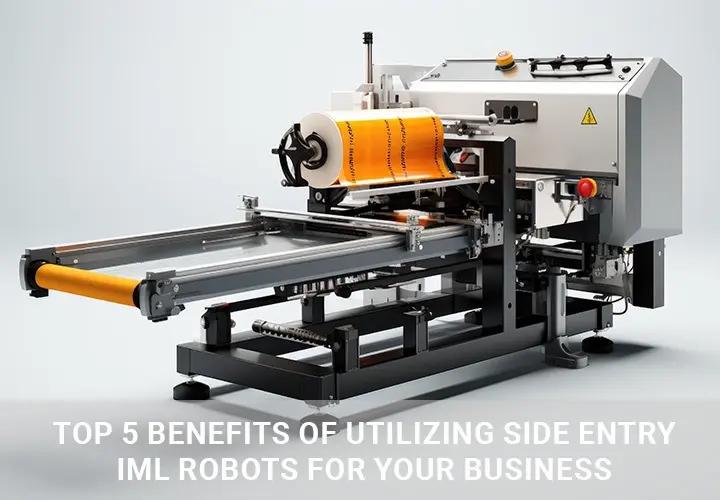
When it comes to industrial automation, companies looking to improve efficiency and streamline operations are finding that incorporating cutting-edge technologies is essential. Side Entry IML robots are a cutting-edge solution in the field of injection moulding operations, providing numerous benefits to organisations across multiple industries.
Implementing side entry IML robots in your business can be a game-changer for your injection molding processes. These advanced industrial robots seamlessly integrate labeling into the molding cycle, enhancing efficiency, precision, and flexibility. By automating the labeling process, side entry IML robots reduce cycle times, increase production throughput, and ensure consistent quality across batches. This increases output and makes it easier for you to satisfy a range of client requests.
Moreover, by minimizing manual intervention, these robots contribute to a safer working environment and optimize resource utilization, ultimately driving cost savings and enhancing your bottom line.
Taking in the Top 5 Benefits of Utilizing Side Entry IML Robots for Your Business can be:
1. Enhanced Efficiency and Productivity
Side entry IML robots revolutionize the injection molding process by significantly reducing cycle times and increasing production throughput. Unlike traditional methods that involve manual intervention for label placement, these robots seamlessly integrate labeling into the molding cycle, eliminating the need for additional steps and reducing production time. By automating the labeling process, businesses can achieve higher efficiency levels and meet increased demand without compromising on quality.
2. Precision and Consistency
Industrial robots are renowned for their precision and repeatability, and side entry IML robots are no exception. These robots ensure precise label placement with minimal deviation, resulting in consistent product quality across batches. Businesses may maintain high quality standards and improve customer satisfaction by reducing the human error and variability involved with manual labeling. Label consistency enhances brand identity and builds consumer trust in the product.
3. Flexibility and Adaptability
Side entry IML robots offer unparalleled flexibility, allowing businesses to adapt to changing production requirements and accommodate diverse product specifications. With programmable features and customizable settings, these robots can handle various label sizes, shapes, and materials, offering versatility in product labeling. Furthermore, they may be easily integrated with the injection moulding machinery that is already in place, causing the least amount of interruption to the manufacturing process when they are put into use. This flexibility empowers businesses to diversify their product offerings and capitalize on new market opportunities.
4. Cost Savings and Resource Optimization
While the initial investment in side entry IML robots may seem substantial, the long-term cost savings justify the expenditure. Businesses can lower labour expenses associated with manual intervention and direct human resources towards more valuable tasks by automating the labelling process. Additionally, the enhanced efficiency and productivity resulting from robot integration lead to higher output levels, optimizing resource utilization and maximizing ROI over time. Moreover, the consistent quality achieved through automation reduces the likelihood of rework or product defects, further minimizing costs associated with wastage.
5. Improved Workplace Safety and Ergonomics
Manual labeling processes in injection molding environments pose inherent risks to workers, including exposure to hazardous substances, repetitive strain injuries, and ergonomic challenges. By deploying side entry IML robots, businesses can mitigate these risks and create safer working environments for their employees. Automation eliminates the need for workers to handle hot molds or engage in repetitive labeling tasks, reducing the likelihood of accidents and injuries. Furthermore, by alleviating physical strain and minimizing ergonomic hazards, businesses can enhance employee well-being and morale, fostering a positive workplace culture.
Real-World Applications Across Industries
The impact of side entry IML robots is being felt across a wide range of industries that rely on injection molding for high-volume production. In the food and beverage industry, these robots ensure that product labels are applied cleanly and accurately—even on thin or flexible packaging. In the cosmetic and personal care sector, where visual branding is crucial, IML robots deliver precise, high-quality labeling that elevates brand appeal. The automotive and electronics industries also benefit from these systems by ensuring durable and consistent label placement for safety warnings, product information, or branding on molded plastic parts.
With the increasing demand for aesthetic packaging, traceability, and regulatory compliance, side entry IML robots have become a go-to solution for businesses aiming to stay competitive. Their ability to maintain tight tolerances while operating at high speeds makes them indispensable in sectors where precision and branding consistency are non-negotiable.
Why Side Entry Robots Are the Preferred Choice for High-Speed Moulding Operations
Side entry robots have become the preferred automation solution in high-speed injection moulding setups due to their unique entry mechanism and ultra-fast cycle times. Unlike top-entry robots, side-entry robots access the mould from the side, allowing for quicker in-and-out movements without interfering with overhead crane systems or other peripherals. This configuration is ideal for IML (In-Mould Labelling) applications where time, precision, and consistency are critical.
What sets side entry robots apart is their optimised stroke path and horizontal design, which not only speeds up the labelling process but also reduces wear on moving components—ensuring longevity and minimal downtime. Manufacturers looking to scale up production with minimal errors and waste are increasingly switching to side-entry robotic solutions due to their unmatched performance in thin-walled packaging, lids, and containers.
Furthermore, these robots come with modular tooling systems and smart controllers, making them easy to reprogram for different mold setups. Whether you’re in food packaging, medical disposables, or consumer goods, side entry robots provide the agility and throughput needed for mass production while maintaining the highest labeling precision.
Conclusion:
So, companies using injection moulding techniques can gain a lot from implementing side-entry IML robots. From enhancing efficiency and productivity to ensuring precision and consistency, these robots represent a transformative solution that drives operational excellence and competitive advantage. Businesses may future-proof their operations, maximize resource utilization, and seize new development opportunities in the quickly changing industrial manufacturing market by embracing automation and utilizing cutting-edge technologies.
